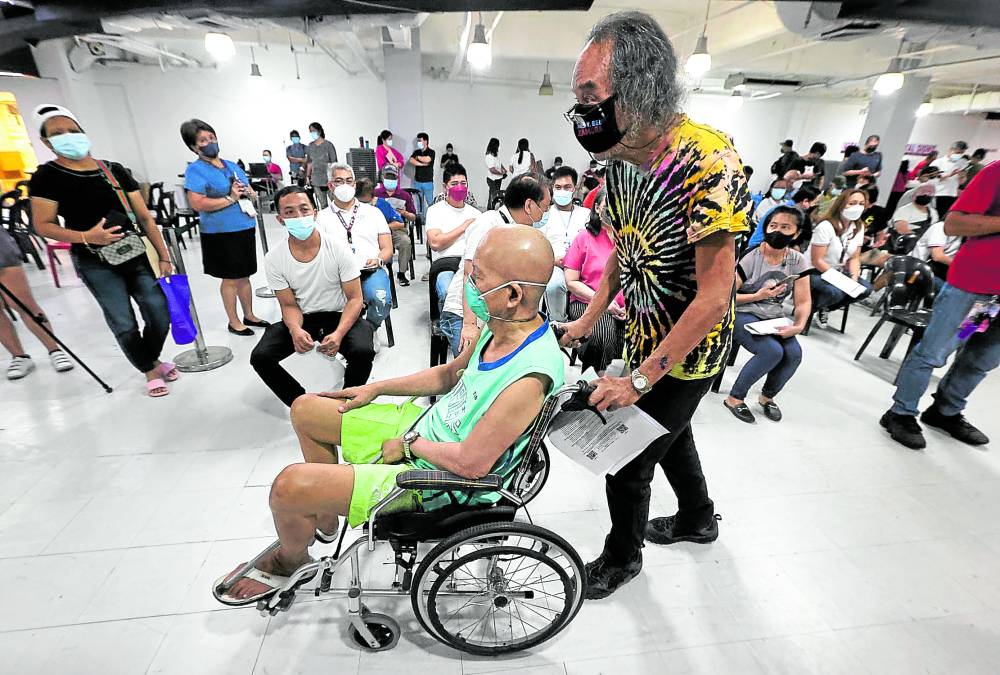NCR COVID-19 risk still low but reproduction rate up

SHOT IN THE MALL An elderly man is wheeled into a vaccination area inside V-Mall in San Juan City on Friday to get his second booster shot. The health department said those eligible to get their second booster dose for now are people who are immunocompromised, front-line health workers and senior citizens. —GRIG C. MONTEGRANDE
The reproduction rate of COVID-19, which gauges the capacity of the coronavirus to spread, rose in Metro Manila to the “moderate risk” level as the number of cases increased by about a fifth in the region a week after the May 9 elections, according to an independent pandemic monitor.
OCTA Research said the reproduction number in the National Capital Region (NCR) was 0.90 from May 13 to May 19, up from the “low risk” level of 0.76 from May 6 to May 12.
At this rate, a confirmed COVID-19 case may infect one other individual.
The seven-day average of new infections also climbed by 19 percent to 71 cases during the same period from 59 cases in the previous week.
But overall, Metro Manila remained at low risk for COVID-19 as other indicators, namely, average daily attack rate, positivity rate and health-care utilization, either remained unchanged or did not indicate enough significant movement to raise the region to a higher risk level.
Article continues after this advertisementAccording to the Department of Health (DOH), Metro Manila’s two-week growth rate, one of the metrics it uses in determining any significant rise in COVID-19 cases, was -17 percent as of May 19.
Article continues after this advertisementIt said in a statement that Metro Manila was still at “minimal risk,” adding that recent increase in cases had not made an impact on the country’s health-care system.
“This slight increase in cases does not translate into increases in admissions or utilization rates which remain at low risk, ranging from 19 to 23 percent of total and ICU [intensive care unit] beds in the capital region,” the DOH said.
The health department earlier this week confirmed the local transmission of Omicron subvariant BA.2.12.1 in Metro Manila as well as in the cities of Puerto Princesa and Iloilo, where the new sublineage was detected.
The World Health Organization has not yet classified BA.2.12.1 as a variant of concern or variant of interest, but preliminary studies found that it is more transmissible than the original Omicron variant BA.1.1.529 and may “most likely exhibit immune evasion.”
It has been detected in the United States, United Kingdom and Canada with a 23 percent to 27 percent “growth advantage” over the so-called stealth subvariant BA.2, which became the dominant COVID-19 variant globally early this year.
Health Undersecretary Maria Rosario Vergeire had warned that cases and hospitalizations may peak at higher levels compared to the Delta and Omicron surges once a variant or sublineage proven to be more transmissible and “immune-escaping” hits the country.
Dr. Rontgene Solante, a member of the government’s vaccine expert panel, said the country may register 500 cases a day should the transmission of the new subvariant hit regions with low vaccination coverage.
Health officials are urging those who are still unvaccinated to get their shots and those who had completed them to get their booster dose to prevent any new surges.
Booster drive
About 40.6 million Filipinos who are eligible for a booster shot have yet to get the jab, according to the DOH.
Oscar Gutierrez, acting officer-in-charge of the Food and Drug Administration (FDA) on Friday welcomed the development of Moderna’s bivalent booster, which is said to be effective against Beta, Delta, and Omicron variants.
“The FDA will wait for the EUA [emergency use authority] application and we will study the clinical trial and other data so that we can also evaluate the safety, efficacy and quality of the vaccine,” he said.
He said no vaccine manufacturer had applied for booster shots for children 5 to 11 years old, which the United States had already approved.
Speaking at Friday’s Laging Handa briefing, Gutierrez committed to finishing the evaluation of any application for booster shots for children in three weeks.
The US FDA has approved the use of Pfizer-BioNTech vaccines for children ages 5 to 11 five months after they have completed their primary COVID-19 vaccine doses.
The first booster shot is now available in the Philippines for individuals who have already completed their primary series of COVID-19 vaccines.
But only immunocompromised individuals, healthcare front-liners, and senior citizens are allowed to take their second booster shot as of now.
Amid the threat of the more contagious COVID-19 subvariants, he also said the FDA had already approved at least 18 home antigen test kits for COVID-19. WITH A REPORT FROM NESTOR CORRALES
For more news about the novel coronavirus click here.
What you need to know about Coronavirus.
For more information on COVID-19, call the DOH Hotline: (02) 86517800 local 1149/1150.
The Inquirer Foundation supports our healthcare frontliners and is still accepting cash donations to be deposited at Banco de Oro (BDO) current account #007960018860 or donate through PayMaya using this link.